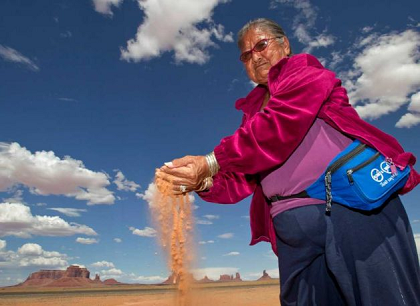Navajo woman helps prompt uranium mine cleanup
Published by MAC on 2011-09-12Source: Associated Press
By Felicia Fonseca
Associated Press
5 September 2011
MONUMENT VALLEY, Utah (AP) - The stretch of high desert on the Arizona-Utah border gives way to towering rock formations that resemble huge mittens, chimney spires and castles. But to the west of Monument Valley lies a reminder of what has been blamed for much heartache and tragedy in Elsie Mae Begay's family: A mesa stained with a gray streak where uranium was mined decades ago.
 |
| Elsie Mae Begay, sifting sand in Monument Valley. Photo: Matt York / AP |
Begay, 71, has spent more than 30 years living among residue piles that her children slid down when they were younger, and other contaminated waste carried down the nearby arroyo or kicked up by high winds. She's taken her story of the dangers of uranium to college campuses and Congress, along with a documentary outlining her family's plight.
Now it's being cleaned up, and Begay is partly to thank.
The U.S. Environmental Protection Agency is wrapping up a $7.5 million project that uses a cable system to transport some 20,000 cubic yards of material up Oljato Mesa, where it came from. A lined repository atop the mesa will hold the waste that Navajo Nation officials eventually want taken off tribal land.
The cleanup at the Skyline Mine * represents not only a reduced risk of exposure for Begay and her family, but marks the first significant remediation of a mine on the country's largest American Indian reservation where such sites number in the hundreds.
Tests have found gamma radiation activity greater than two times the background level at 80 locations on the site. In the traditional Navajo home where Begay once lived with two of her sons, the radiation levels were up to 100 times the acceptable level. The two sons have died - one of lung cancer and the other from a tumor. The EPA tore down the home in 2001.
"What we've been asking for is not fallacy," said Stephen Etsitty, executive director of the tribe's EPA. "It's not stuff we're making up. There are real problems out there that need to be addressed."
The family's troubles with uranium are highlighted in a documentary about Begay's brother, who was adopted by white missionaries and later reunited with his family, and in the book, "Yellow Dirt: An American Story of a Poisoned Land and a People Betrayed." Begay has traveled across the reservation and the country with the film, "The Return of Navajo Boy."
There's little doubt that the film and Begay helped push the Skyline Mine higher up the priority list for cleanup. But the Navajo Nation Environmental Protection Agency notes that its efforts to map the extent of abandoned uranium mines and the impacts of contamination on the vast reservation began well before the film was released in 2000. An epilogue was added in 2008, and videos posted online document the cleanup.
"Hard to say how it might have been ranked," said Jason Musante, who is overseeing the cleanup effort for the federal government. "Its visibility alone may have kicked it up the scale. That film and Elsie's involvement definitely brought it to the forefront."
Skyline is one of six regions where uranium was mined on the reservation that stretches into Utah, New Mexico and Arizona. Nearly four tons of ore was extracted from Navajo land over more than four decades. Miners mostly scraped the surface and sent the ore down a gondola on a cable system, then trucked it away from the valley floor. Concerns over safety and the health of its people led the Navajo Nation to ban any further uranium mining in 2005.
Begay shields her eyes from the sun as she looks from her home toward the mesa. The only sounds come from the machinery hauling the dirt from the valley floor. A flock of sheep grazes nearby as Begay recalls warnings not to eat such animals for fear they drank tainted water or breathed in contaminated dust that could sicken people.
When anyone gets sick here, they often point to uranium as the culprit. Local high school principal Pat Seltzer estimates that 60 percent of the students in grades 7-12 have a family member whose death they trace to uranium.
* Editorial note: The Skyline uranium mine was among 25 mines and properties acquired in 2009 by the Fortress Financial Group.